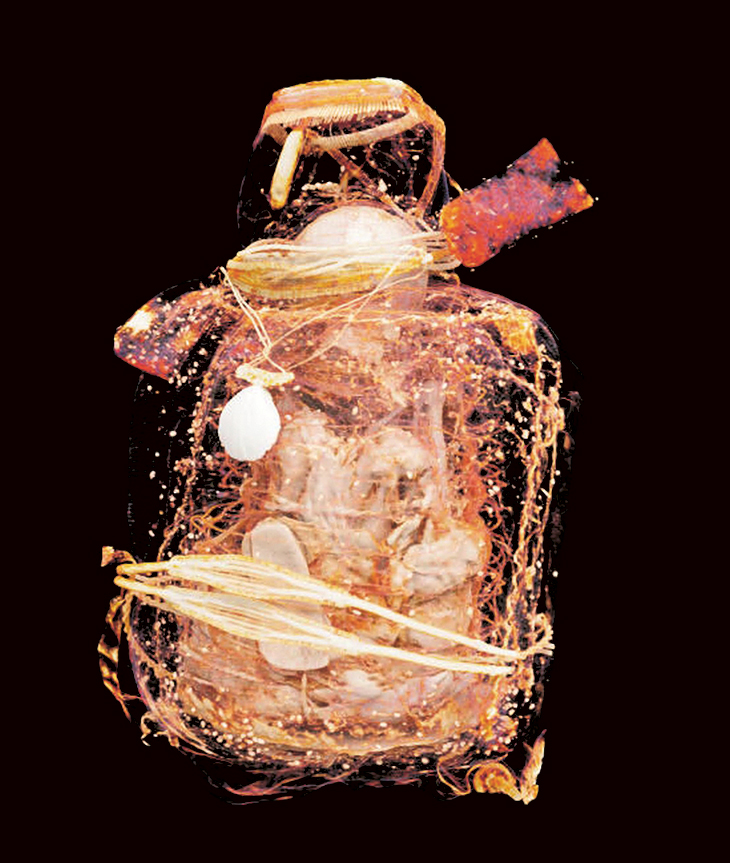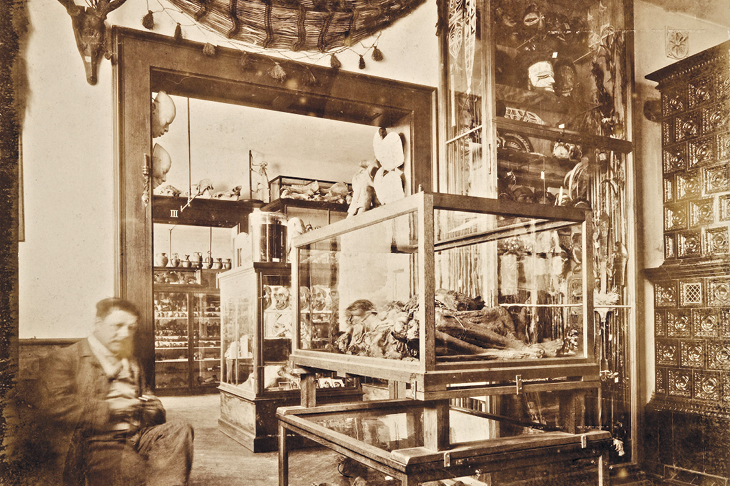Picture a mummy in your mind. You’re probably thinking of a preserved and bandaged corpse from ancient Egypt. But the word today has a wider meaning, covering preserved bodies, whether of people or animals, from across the globe. The frozen corpses of the Franklin expedition crew in the Arctic, Dutch bog bodies, or a desiccated mouse, snuggled in the corner of a dry attic, are just as much mummies as the Egyptian pharaohs Tutankhamun and Rameses II. There’s more to mummies than bandages, magical amulets and tombs.
So it’s always refreshing to visit an exhibition dedicated to the subject as a whole, rather than just to ancient Egypt. The current show at the Reiss-Engelhorn-Museen, ‘Mummies: Secrets of Life’, presents the ongoing work of the German Mummy Project, based at the museum. Since 2004, when the museum rediscovered a forgotten group of mummies that had belonged to the artist Gabriel von Max, researchers have used the latest scientific methods to uncover as much information as possible about these and other figures, revealing new details about their lives and deaths. This exhibition highlights these discoveries and their significance, as well as the science behind them.
These aims are explained at the start of the exhibition, beside a giant map showing where mummies are found across the globe (almost everywhere), and a panel addressing the ethics of displaying human remains. From there, the exhibition can be divided into two major sections, together displaying around 50 human and animal mummies. The first covers the conditions that create mummies – deserts, ice, salt, bogs, artificial spaces. The second takes you on a journey across cultures and time. This features mummies from around the world – ancient Egypt, Asia, Oceania, South America, and Europe – and explains the results of the recent investigations, often accompanied by videos of 3D reconstructions, whizzing us around and zooming in on important discoveries. The present day is represented by plastination and cryonics.
Inca mummy bundle, dressed in the tunic of an Incan officer but containing the mummy of a boy, from c. 1480–1560, Museum der Kulturen, Basel

As you might expect, the researchers uncovered some surprises. One Egyptian mummy – only his half-wrapped head surviving – probably suffered from a tumour on his pituitary gland. Another Egyptian mummy head revealed a fracture in the skull; this unfortunate woman was probably murdered, smashed over the head with a blunt object. An Incan mummy bundle, wearing the tunic of an Incan officer, actually contains the remains of a boy aged between seven and nine; grave robbers probably wrapped the officer’s tunic around the bundle to make it easier to sell. The boy himself suffered from multiple diseases, both hereditary and infectious. A Peruvian mummy clenches baby teeth in her hands. Nobody knows why. A Slovakian nun, buried in Hungary, was missing her heart; was it sent for burial in her home town?
Not all the results are as showy or mysterious. It’s often progress simply to reveal an individual’s origin, sex, and age – not always as obvious from the physical examination of a mummy as you’d expect. Researchers knew next to nothing about the mummy of one woman before the recent studies; using various techniques, they found that she came from Oceania, died between the ages of 35 and 50, suffered from severe tooth decay, and ate mainly vegetables and seafood. Another mummy turned out to be that of a young man, aged between 15 to 17, from north-east Asia. His brain and viscera are missing, leading researchers to speculate that they were purposely removed. (The viscera were perhaps taken through the man’s back, where parts of his spine are absent.)
But the exhibition isn’t just about the discoveries. As you walk among the bodies, you notice small details: the gold leaf still present on the face and hands of one Egyptian noble; the artificially elongated head of a mummy from Peru’s Nazca Culture; the braids in a South American woman’s hair; the black silk ribbon carefully tied in a bow around a nun’s hands. This window on to world cultures enables us to meet people that lived in times and places different from our own – mummies are cultural ambassadors beyond death, unwitting time travellers.
A 3D-reconstructed image of the mummy inside the Incan mummy bundle (above)

Nonetheless, because the exhibition’s main focus is on scientific results, which tend to reveal physical ailments, we often learn little about the individuals’ lives beyond the suffering they endured. The show is a reminder of how much pain our ancestors lived with on a daily basis, and how often they died young. This is most prominent towards the end of the exhibition, in a section dedicated to naturally preserved bodies found in the crypt of a Dominican church in Vác, Hungary. Of the 265 mummies discovered, almost 70 per cent suffered from tuberculosis. Among those on display is that of Katalina Orlovits, who died at the age of two and a half in 1798; she lies there in her yellowing white dress, still wearing her bonnet. Nearby lie the mummies of 26-year-old Terézia Borsodi and her child, still held in her right arm. Both died shortly after the birth in 1794.
‘Mummies: Secrets of Life’ succeeds in its aim of highlighting the often surprising, always intriguing, new discoveries emerging from scientific mummy research. Displays dedicated to explaining scientific techniques and technology hammer the point home. But this comes with a drawback: by focusing on each mummy’s physical and medical history, exploring the exhibition can feel a bit like touring a morgue, reading each corpse’s record while passing from body to body. This feeling isn’t helped by the exhibition’s repetitive turquoise and white colour scheme, which has a certain clinical feel to it. Early on, a panel on the ethics of displaying human remains emphasises that mummies are ‘invaluable archives of life’ and that the topic is examined ‘subject to the terms of respectful presentation’. Consequently, the rather sombre atmosphere is perhaps a result of the curators trying to steer away from the sensationalism and dehumanisation that the word ‘mummy’ conjures and creates; in this exhibition, a mummy is emphatically a deceased being, not a symbol of heroic adventure, not another tomb treasure, and not an exotic synonym to help you forget that you’re viewing a desiccated corpse. Even so, additional general context, where possible, about social life in the mummies’ home cultures and communities would have helped to alleviate some of the scientific detachment.
Nonetheless, the exhibition provides a valuable insight into the inspiring cutting-edge science revolutionising our knowledge of mummies from across the world; every new fact is a piece of someone’s life regained, and adds to the bigger picture. Without inscriptions, and even without any archaeological context, the dead can now tell us something of their lives, about their suffering and deaths. It is important to listen.
‘Mummies: Secrets of Life’ is at the Reiss-Engelhorn-Museen, Mannheim until 31 March.
From the January 2019 issue of Apollo. Preview and subscribe here.



